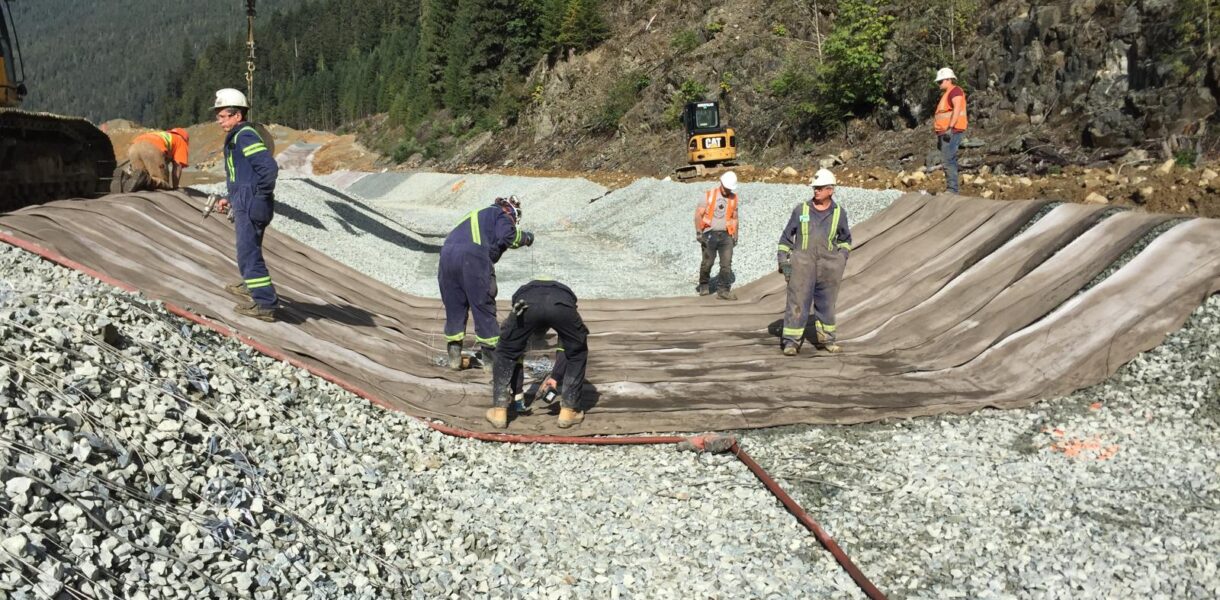Project Overview
In August of 2016, 11,125 sq. m’s of Concrete GCCM 8mm (CC) was used as a protective liner for a large diversion ditch at an underground zinc and copper mine on Central Vancouver Island in Canada. The diversion ditch, which conveys clean water from the hillside above to a lower creek, was originally lined with shotcrete but the material had begun to degrade over time.
It was recommended that the diversion ditch should be enlarged and realigned to effectively handle the high water volume and velocities. Alternative options such as new shotcrete were considered, however CC8 was specified due to its ability to cope with high water velocities, its ability to accommodate the variance of profile and the ease of repair if future damage occurred due to falling trees or large boulders from the above hillside. Since the water was diverted away from the ditch during installation, the speed of installation was key as the diversion pipes wouldn’t be able to handle the high water volume expected to begin in early October.
The use of CC meant measures could be in place much faster than using conventional concrete or shotcrete. The ditch was designed to handle water velocities up to 20m/sec with slopes as steep as 16% and 20% in some sections.
Solution
The fiber reinforcement inherent in CC gives a durability and design life well above competitor geomembrane products, whilst the integral PVC backing ensures minimal water loss in the diversion ditch. Prior to excavating the new diversion ditch. The main contractor completely removed and disposed of all trees, brush and other vegetation growth in the area. Any standing water was drained away from the exposed excavated areas to prevent pooling and infiltration. Prior to installation a new ditch was created by the main contractor which was significantly wider than the original shotcrete lined ditch. The final ditch measured 735m in length, 5m to 8.5m wide and an average depth of 1.5m with a 2:1 side slope.
The CC8 bulk rolls were delivered to site and positioned strategically along the ditch to save time during installation. For the transverse layup, a spreader beam and excavator were used to unroll the bulk rolls of CC8 across the width of the ditch. Adjacent layers of CC8 were overlapped by 100mm in the direction of water flow and secured using 1.5m earth percussion anchors with 3mm stainless steel cables every meter along the overlaps in conjunction with #8 stainless steel 1” screws at 150mm intervals. The GCCM was pinned into 300mm deep anchor trenches on either side of the ditch using the 1.5m earth percussion anchors. The trenches were then backfilled with material to provide a neat termination and prevent water ingress underneath the material. When fixing the GCCM to rock in some sections of the ditch, hilti rock anchors and 600mm rock bolts were used. The material was hydrated using a water truck and due to CC having a very low wash out rate and a low alkaline reserve, treatment of the run off from installation was not required. CC has a working time of approximately two hours from hydration, meaning that work can continue even in very wet conditions. This can reduce program disruption typically caused by bad weather when using traditional solutions.
Results
The installation took 6 weeks to complete with an average crew size of 6 men and daily temperatures up to 34 degrees C. The client was satisfied with the product and the minimal amount of special training or equipment required. In addition to this, the speed of installation meant the project was completed before the heavier precipitation arrived at the mine in early October which may have caused significant project delays.




